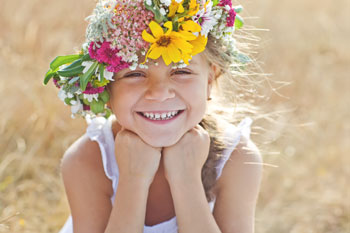Children & Baby Teeth
Baby Teeth
Just because baby teeth (or “primary” teeth) are shed, does not mean they are unimportant! Your child needs them to function in chewing, develop speech, and hold space for unerupted permanent teeth. If neglected, these teeth will develop cavities which can lead to infection and abscess, similar to adult teeth. This not only has an effect on the child’s well being and health, but can increase the risk of tooth decay in permanent teeth later.
Primary teeth begin forming in utero and start to erupt in the mouth at 6-12 months of age. Most children have all 20 primaryteeth by the time they are 3 years old.
Sugary foods and drinks lead to tooth decay and the longer and more frequent the exposure, the more likely a cavity is toform. Limit snacking and sipping sugary juices (watering down juice does not help, it is still a source of sugar!) to meal time. Sticky, gummy foods like some candy and dried fruit (yep even all natural) will stick to the crevices of the teeth for several hours increasing exposure time. Babies should not be put to bed with a bottle because milk or juice can stay in the mouth throughout the night, coating the teeth. Dipping pacifiers in sugary liquid or honey should be avoided, as well as adding extra sugar to your baby’s food to make it taste better.
Home Care for Babies and Toddlers
Before eruption of the first teeth, a damp guaze or washcloth can be used to wipe the gums removed plaque and food debris that can harm new teeth. This can done after each feeding or even during bathtime. After the eruption of the first tooth, begin brushing with a pediatric sized tooth brush. Children under 2 years tend to swallow toothpaste. Excess fluoride consumption during this time may lead to problems in the developing permanent teeth. Consult us prior to using a fluoridated toothpaste under the age of 2. For children age 2 to 6 years old, use only a grain of rice sized amount of fluoridated toothpaste. Fluoride is extremely protective of the teeth, but because there are many sources of fluoride, it is important to talk to us about whether or not your child is receiving the right amount.
Cavity causing bacteria can be transferred from parent or sibling to baby. Always rinse pacifiers with water, not your own mouth, and avoid sharing cups and utensils.
First Visit
The ADA and American Academy of Pediatric Dentistry says that the first visit should occur within 6 months after a baby’s first tooth appears but no later than the child’s first birthday. However, it is never too early to come in for a quick exam, possibly in conjunction with another family member’s visit, and discuss healthy habits including wiping the gums and teeth. It is better to let children familiarize themselves with the dental office, staff, and having their teeth “counted” before there is a problem and treatment is actually needed. We participate in the Baby Oral Health Program (bOHP) and would be happy to answer any questions you may have about your child’s growth and development.
Morning appointments work well, as children tend to be rested and cooperative. Our aim is to prevent any dental problems from occuring in the first place. Do not share any fear or anxiety that you may have from other experiences. Try to stay positive! Avoid bribery or using a dental visit as a punishment. We will do everything we can to make sure your child has an enjoyable experience and is set up for dental success, but we must all be on the same team!



